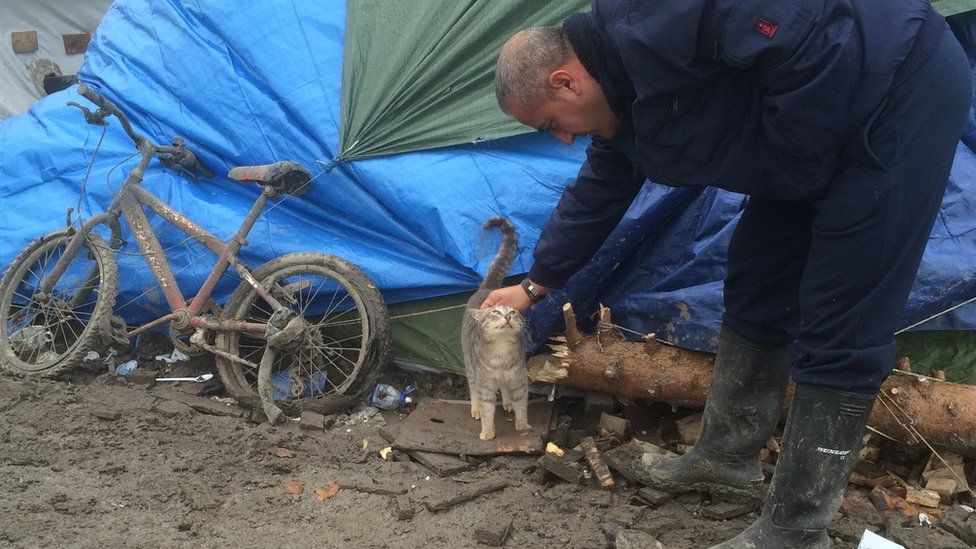A look round Dunkirk's migrant camp
- Published

It is a wooded, boggy piece of land in Dunkirk 3,000 migrants have made their home.
It is smaller camp than the more notorious "Jungle" camp just down the road in Calais but conditions here are said to be much worse.
I imagine seeing the camp emerge as we approach from a distance but it was not like that.
The camp is situated right next to a residential area of the town; the houses are nice - balconies, 4x4s outside, and just 50m (164ft) from these front doors is a line of French police officers guarding the camp.
Mud can be seen on all the pathways in and out, it is as if it is escaping.
Inside the camp your senses are bombarded straight away and the smell hits you - it is a mix of drains and rubbish. There are some portable toilets in the camp, 15 at the most.
But during the time I am in the camp I only see one person venture in to use them.
The rubbish is incredible.
Piles and piles of bin bags everywhere just yards from where people are a sleeping. Lots of it does not even make it into the bags; there are cardboard plates with leftover food dumped on the side and banana skins everywhere. I do not see any rats when we are in the camp, but they are there.
They have named the main route through the camp "Queen Elizabeth II Street" but there is nothing regal about this road.
The mud is not like any mud I have ever seen before. Thick and gloopy - it looks more like slurry. And it is everywhere.
Then there is the noise. Flimsy tents, many with tarpaulin over them, flapping furiously in the wind - it must be deafening at night.
The camp is home to a mix of people but there are many more families here than in the Jungle camp.
One family catches my eye. A man carries a toddler on his shoulders - she is a pretty little thing, smiling under her dummy, seemingly content. Her mother follows, slightly behind.
As the day goes on I see them several times, they seem to be walking back and forth along the main path all day.
There are not any soft play centres or swimming pools to keep a toddler occupied, so I suppose it is best just to keep walking.
As a mum of a little boy of a similar age, I cannot help thinking silly things when I see her..."I hope that dummy doesn't fall in the mud".
But I suppose her mother has more important things to worry about.
Many of the people here are Iraqi Kurds. We spoke to one man called Pesewa who agreed to show us where he sleeps.
As he opened the zip of the tent, my first impressions were: "It's cosy in here, it's clean - it's not that bad."
But here are the facts; This is a one-man tent where Pesewa lives with his wife. So the couple are not sleeping on the mud, there are two palettes as a base in the tent.
On top as padding is a blanket. That is it. The heat is coming from a small gas stove.
"Is this safe?" I ask Pesewa. He smiles sheepishly.
This is where Pesewa's wife spends the whole day. She will soon be making dinner - rice and beans and maybe some chicken.
Pesewa is a UK passport holder. He was working in Luton when his wife rang and said she was in France. The UK authorities will not let her into the country.
"Where are you from?" Pesewa asks.
"Wales." I say.
"Cardiff?"
It turns out Pesewa lived in Cardiff when he first claimed asylum in 2004. He remembers the city well. It is clear he has good memories of living and working in the UK. He does not want to be here.
As we leave the camp, it is difficult to process what we have seen. One person we are travelling with says: "It's like Glastonbury but gone horribly, horribly wrong".
It is a crude comparison in many ways, but it works.
- Eye on Wales, BBC Radio Wales, 12:30 GMT Sunday
- Published16 October 2015
- Published25 September 2015
- Published3 October 2015